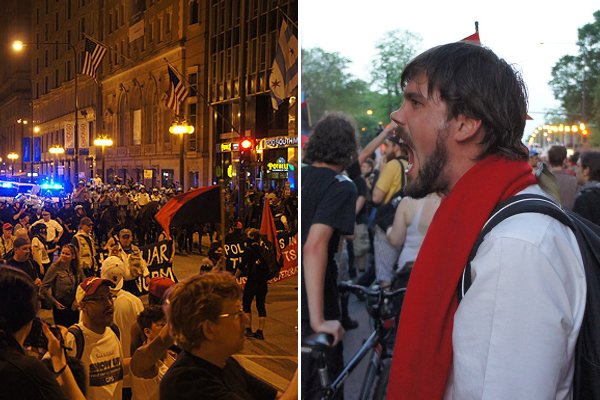A rally for the “NATO 3” turns into an impromptu march, leading protesters and police on a day-long, miles-long journey through the Loop, South Loop, and West Loop, resulting in six arrests and a protester being struck by a CPD van.

The arrest of three men on suspicion that they intended to attack city targets, including police stations and squad cars, with Molotov cocktails, resulted in a rally in support of the quickly dubbed "NATO 3," or #NATO3 in Twitter parlance, at Daley Plaza yesterday around 3:30 following a march on Rahm Emanuel's house. The rally was organized into an unplanned march, which was led (and led by cops) in a winding, eight-hour trek with the march shrinking and growing throughout the day, crossing the Loop several times and going deep into the South and West Loop. Six arrests were made, and shortly after 10 PM a protester was struck by a police van and carried away on an ambulance.
In a brief press conference following the van incident, CPD chief Garry McCarthy discussed the problems of containing a march led by protesters who didn't know where they were going. The police attempted to facilitate the march by doing what were essentially rolling blockades: guiding the marchers along main streets by blocking off side streets with cops on bike, on foot, and on horseback. When the marchers passed, the bike-mounted police would file out and head for the next block, passing protesters on the shoulder and on the sidewalk; vans would follow the march on streets a block away, drive towards the path of the march, and police jumped out and blocked the side streets on foot. In the photo gallery, you can see how the cops set up on-the-fly paths to guide the protesters down and across streets.
The protesters guided the march in a slow dance with the CPD through mic checks, crowd momentum, and Twitter. When the march got too fast and the protesters too separated, bullhorn-wielding organizers directed the group to "slow down, tighten up," and the message was relayed with shouts and runners up and down the line. Mic checks also served as crowd control: when the march approached a fence at Kinzie, several protesters yelled to tear it down, countered by marchers telling them "you do not have the support of the people." Voted down, a small group ran down a side street. Here the march split, seeming to vanish, and this is where Twitter served as a backup navigational system. Tweets from other protesters guided me back towards the main stream of the march.
Early in the afternoon, the plan seemed to be to just let the protesters march south on Michigan until they dropped or got to the Indiana border. (A couple protesters did drop in the heat, and were attended to by the organizers' roving staff of medics; due to the improptu nature of the march, not everyone was carrying water for what became a walk of five or ten miles, myself included.) The arrests and detentions occurred when protesters attempted to go through police lines; the first incident occurred when protesters tried to turn west from Michigan Avenue—the march had gone all the way from Wacker and Michigan all the way to 18th Street—and were stopped. Another such incident, recorded here, occurred from a block at State and Washington.
The march didn't always come to a halt or result in arrests when the police tried to block or turn it. Early in the afternoon, the cops set up a block on southbound Michigan Avenue; the protesters came to a stop, a couple sat down in front of the cops, and a chant began. After a short standoff, the police allowed the march to continue down Michigan. Later in the evening, the march went south on LaSalle, through traffic, and stopped at the Board of Trade, a T-intersection that allowed police to kettle the march. But after another standoff, the CPD let the march through again, which continued west.
Protesters then moved past the Willis Tower onto the Jackson St. bridge, where the protestor was struck by the van, which accelerated through the middle of the march. I was at the front of the march across the river, so I didn't see the incident, only the aftermath. The organizers' medics circled and attended to the victim, while more medics talked down angry protesters who were verbally lashing out at the police, and in one case, trying to swat away television cameras. And a mic check (the march's way of disseminating information and coming to agreement) cleared a path for an ambulance. It has, however, been filmed from multiple angles, both by news cameras and the many, many protesters carrying cameras and live-streaming the protest—in the gallery, you can see the media scrums that resulted from any police-marcher conflict.
In his brief appearance at the scene, McCarthy said that protesters had slashed the tires of the van as it proceeded through the crowd. On WGN, which captured the van on camera, Julie Unruh reported that she saw this first-hand. McCarthy also said that protesters had punched officers inside the van; CBS Chicago just reported that one was being treated for a concussion.


